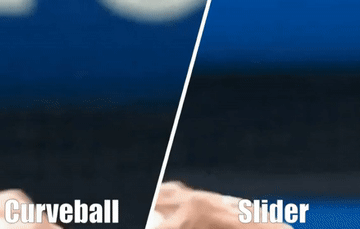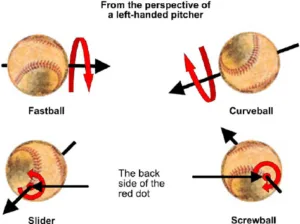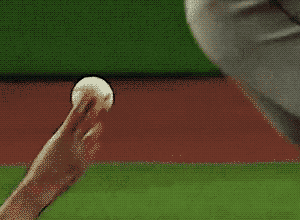Gaining mastery over a wide range of pitch types is critical for a pitcher's success in baseball pitching. Curveballs and sliders stand out among the enormous arsenal of pitching possibilities, each with its own distinct characteristics. This comprehensive study delves into the subtleties that distinguish these two pitches: the curveball and the slider. Throughout our investigation, we will uncover the causes why the curveball's lesser velocity than the slider, which is a result of its grip, which leans toward more wrist supination. Join us as we thoroughly explore the mechanics, various grips, and tactical applications of these pitching styles.
What Is the Difference Between a Curveball and a Slider?
 The grip and the resulting spin and movement patterns are at the heart of the distinction between a curveball and a slider. A curveball is thrown with a stronger supinated wrist grip, resulting in a downward and slightly lateral movement. A slider, on the other hand, uses a more pronated grip that produces hard lateral movement with less downward action. This grip discrepancy results in different trajectories and velocities.
The grip and the resulting spin and movement patterns are at the heart of the distinction between a curveball and a slider. A curveball is thrown with a stronger supinated wrist grip, resulting in a downward and slightly lateral movement. A slider, on the other hand, uses a more pronated grip that produces hard lateral movement with less downward action. This grip discrepancy results in different trajectories and velocities.
The Science of the Curveball
The curveball gets its quick downward break from a high degree of wrist supination during release. Pitchers who understand the curveball grip can alter the ball's spin axis, causing it to twist with topspin. This topspin causes a difference in air pressure on top of the ball, forcing it to drop rapidly as it approaches the plate. The slower velocity of the curveball is due to the increased air resistance produced by its considerable topspin rotation.
The Characteristics of the Slider
The slider, on the other hand, is thrown with a grip similar to a fastball but with a small wrist tilt. This grip produces lateral movement similar to a cut fastball. The lateral break of the slider is more significant than that of the curveball, and it does not descend as dramatically. Because the grip is similar to a fastball and there is less air resistance on the pitch's spin axis, its velocity is often higher than the curveball.
Curveball Sharp Drop vs. Slider Lateral Movement Trajectories
Curveball's Tricky Trajectory
 When a batter faces a curveball, they are presented with a trajectory that appears to defy physics. The curveball's quick downward break can mislead batters to misread its landing location, resulting in swings and misses or weak contact. The curveball's unusual trajectory makes it a useful pitch for inducing ground balls and strikeouts.
When a batter faces a curveball, they are presented with a trajectory that appears to defy physics. The curveball's quick downward break can mislead batters to misread its landing location, resulting in swings and misses or weak contact. The curveball's unusual trajectory makes it a useful pitch for inducing ground balls and strikeouts.
Sideway Break of the Slider
The lateral movement of the slider, on the other hand, makes it difficult for batters to correctly predict its course. The horizontal break of the slider can make batters swing early or late, resulting in awkward swings and weakly hit balls. Because of its ability to avoid the barrel of the bat, the slider is an excellent pitch for generating ground balls and forcing weak contact.
Difference Between a Curveball and a Slider: Strategic Applications
Pitching a Curveball as an "Out" Pitch

Fastball stays up, Curveball moves down, and Slider runs into hitter.
Pitchers frequently use the curveball as an "out" pitch, especially when they are ahead in the count or want to finish a hitter. Its abrupt drop, along with its slower velocity, can take batters by surprise, resulting in swings and misses or mistimed contact. The usefulness of the curveball resides in its ability to disrupt a batter's timing and provide beneficial results for the pitching team.
The Versatility of the Slider
With its lateral movement and higher velocity than the curveball, the slider gives pitchers more options in pitch selection. It can be utilized as a strikeout pitch as well as a ground ball inducer. Pitchers frequently employ the slider to move the ball out of the batter's power zone, forcing him to reach or make off-balanced contact.
TopVelocity Patreon can help you unlock your pitching potential
 Are you an aspiring pitcher who wants to take your game to the next level? There is no need to look any further! Join the TopVelocity Patreon group to obtain exclusive access to a wealth of tools aimed at honing your pitching abilities. Whether you prefer the curveball or the slider, our Patreon provides an excellent opportunity to learn pitch grips and much more.
Are you an aspiring pitcher who wants to take your game to the next level? There is no need to look any further! Join the TopVelocity Patreon group to obtain exclusive access to a wealth of tools aimed at honing your pitching abilities. Whether you prefer the curveball or the slider, our Patreon provides an excellent opportunity to learn pitch grips and much more.
By becoming a member, you will receive incomparable perks such as remote coaching sessions geared to your specific needs. Our knowledgeable instructors will lead you through tailored training routines, providing insights and solutions to improve your pitching effectiveness. However, as a patron, you will also receive weekly video analysis of your throwing mechanics, allowing you to discover areas for improvement and make required improvements.
Don't pass up this opportunity to improve your pitching skills. Join our TopVelocity Patreon today and start your journey to greatness and growth. Unleash the power of your throws and baffle hitters with your newfound abilities. Your journey to throwing greatness begins here!
FAQs: Difference Between a Curveball and a Slider
- What Are the Primary Distinctions Between a Curveball and a Slider?
The primary distinctions between a curveball and a slider are in their grip, spin, and movement patterns. A curveball has more wrist supination, which results in a strong downward break, whereas a slider has more lateral movement with a less obvious drop. - Why is a curveball slower in velocity?
The slower velocity of the curveball is due to its topspin rotation, which causes more air resistance and drag. As the ball approaches the plate, the topspin rotation, achieved through wrist supination, forces it to drop abruptly. - What Is the Difference Between a Slider and a Curveball Grip?
A slider is held in the same way as a fastball, but with a small wrist tilt. This grip causes lateral movement, causing the slider to glide sideways rather than sharply falling like a curveball. - Which pitch is better at inducing ground balls?
Both the curveball and the slider have the potential to induce ground balls, but the curveball's sharp downward break makes it particularly effective at getting hitters to make contact on top of the ball, leading to ground balls. - Can Pitchers throw curveballs and sliders in the same game?
Yes, pitchers often mix curveballs and sliders to keep hitters off balance. Batters may be confused by the difference in movement patterns and velocities between the two pitches. - Is it difficult to learn curveballs and sliders?
Curveballs and sliders both necessitate repetition and mastery of precise grips and wrist actions. While challenging, the reward of adding these pitches to a pitcher's arsenal can greatly enhance their effectiveness on the mound.




